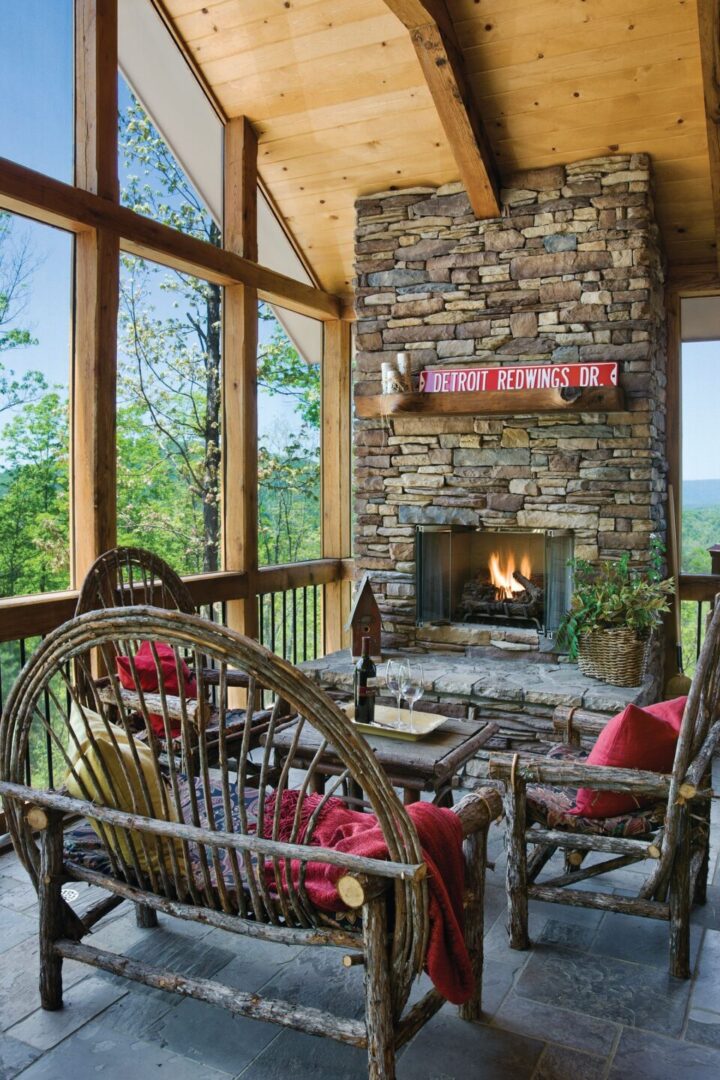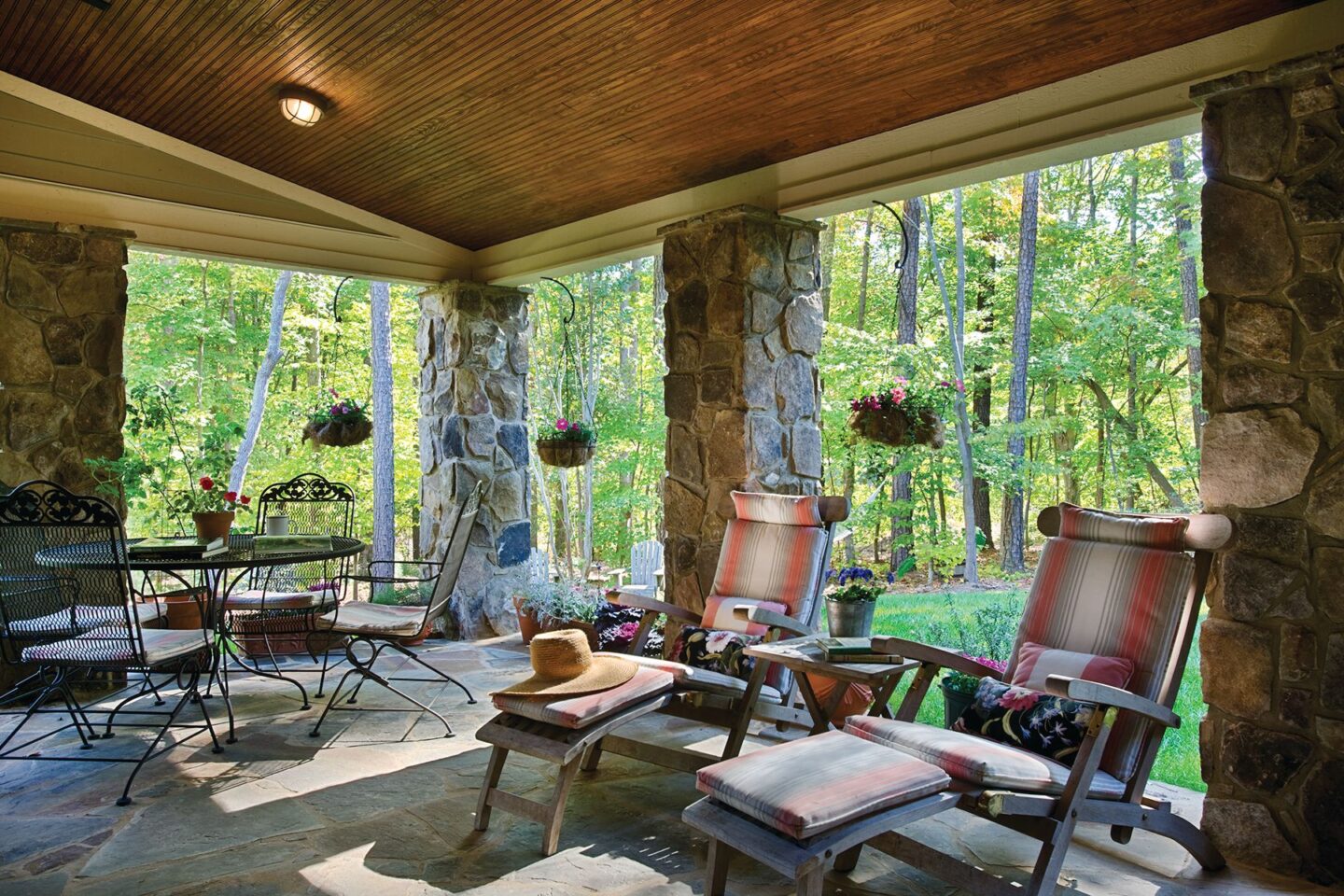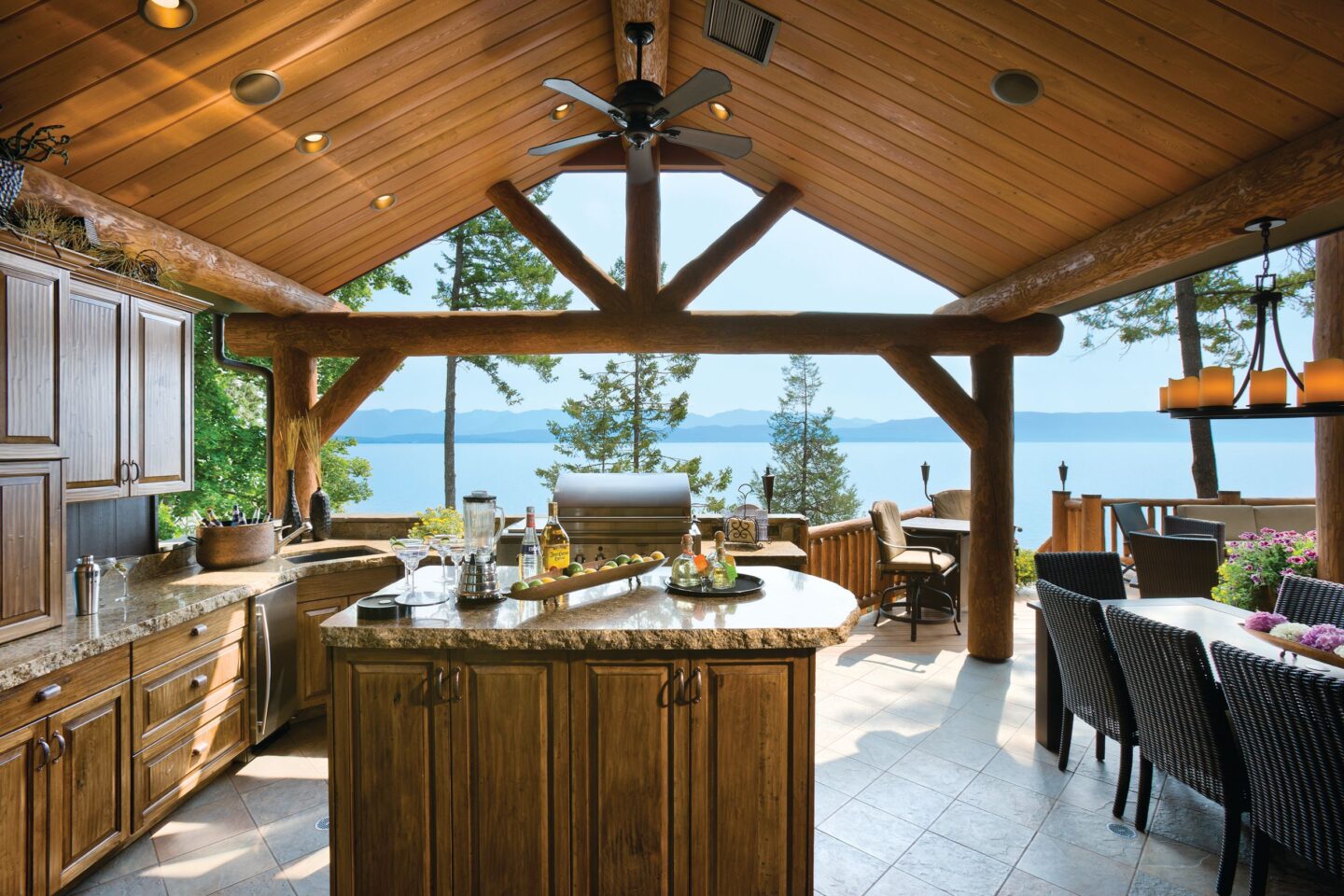There are a vast number of ways to create outdoor living spaces that harmonize beautifully with log and timber homes.
As the seasons change, our thoughts turn to outdoor living. The longer days, blooming flowers, and the intoxicating smell of barbecue smoke lures us outside to spend time with family and friends. Learn how to create harmony with the ideal outdoor living space for your home’s design with these 11 tips:
1. Review What You Value
The pandemic changed us in many ways. But one of the most profound was reconnecting with nature via our outdoor living spaces. A full 90% of Americans agree their outdoor living spaces are more valuable than ever before, with 78% spending significant amounts on upgrades, according to recent polls.
Homebuyers rediscovered their backyards during the pandemic, but now that the pandemic is history, they want to continue to add fun and functionality to these spaces, says Allen Holcomb, president of MossCreek (Knoxville, Tennessee), a design firm that specializes in rustic designs.
“Do you need exterior patios, decks, porches, and other landscaped areas? Most people enjoy them. Odds are you will too. An important first step is to take an honest look at how you might use them. Are you a social butterfly with large parties? Or do you have events with lots of extended family? Or are you someone more likely to have just a few friends or another couple over on occasion? Questions like these can help determine the size and budget to set for your exterior areas,” Holcomb says. Possible considerations include:
- How many dinner parties or BBQs do you typically host?
- How many guests do you entertain?
- Want a quiet space to relax and unwind?
- Will you need spaces dedicated to pets or children’s play areas?
- Would you like fresh eggs from a chicken coop or fresh honey from hives?
- How much space do you have to work with and what will you need?
“To get a concept started, take a moment and imagine how you would like to entertain in your new or existing home, and how exterior spaces such as porches and patios could work in harmony with your interior spaces so that each enhances the other,” Allen says. “For example, a carefully located outdoor grilling/cooking area might be well suited if it is adjacent to the main kitchen. An outdoor fire pit and seating area may be pleasant as a walkout from the main dining area for after-dinner sunsets. Imaging the flow of events as you would entertain is a great way to get started.”
2. Consider Hiring a Designer
Because you don’t want to spend your hard-earned money on an unworkable design, consider investing in a landscape architect or a landscape designer for help with the design. “They can often bring a fresh perspective to your building site,” Allen says.
Costs for such services will vary, usually $1,000 to $6,000 for design plans, or 5% to 20% of the total project’s costs, or $100 to $250 per hour.
3. Review Your Surroundings
“Outdoor areas such as decks, terraces and porches are a great way to transition your home to the outdoors, and vice versa,” says Tom Steber, National Home & Design Consultant at Wisconsin Log Homes, Inc. (Green Bay, Wisconsin).
“As you begin to plan your areas, think about the direction of your views, prevailing winds, unsightly views you might want to mask, and other aspects handed to you by the site. Some of your solutions may be achieved architecturally, and some may fall into hardscaping and landscape architecture categories,” says Tom.
4. Introduce Landscaping Sustainable
What kind of plants will add color, texture, and life to your outdoor space without needing a lot of maintenance? What plants can be used to hide utilities, or help hide neighboring structures? A landscape designer can provide a host of suggestions.
Bear in mind, more and more homeowners are opting to employ sustainable landscaping techniques when finishing their outdoor spaces. This can help the local environment while saving the homeowner the costs of energy, water, and maintenance. Advantages include:
- Requires little to no fertilizers or pesticides to thrive
- Conserves water
- Minimizes rainwater runoff and polluting local waterways
- Provides a habitat for wildlife
- Is typically minimal maintenance
Aren’t all landscapes good for the environment? Not exactly. The Earth’s soil is a valuable resource and plays a vital role in the ecosystem. Sustainable strategies can include erosion control, such as:
- Rain gardens
- Swales
- Dry creek beds
- French drains
- Retaining walls
- Terrace gardens
- Ground covers
Another sustainable strategy is the use of native plants instead of non-native plants.

5. Plan for Comfort
Outdoor spaces receive a lot of afternoon or early evening sun. What kind of structure will you need to provide comfort? Stylish ideas will help you take advantage of the great outdoors and savor all seasons. A simple covered deck or porch provides a cozy setting for casual gatherings; other options include:
- PERGOLA: A pergola to turn your backyard into a private getaway. A pergola design adds both style, structure, and charm to decks and patios without taking up much space.
- DECK-PATIO COMBINATION: Keep the grill and dining area close to the kitchen, then place a separate gathering space with lounge chairs to encourage more face time with your friends and family.
- GRILL ZEBO: A melding of a gazebo with grilling space can be a great gathering space for friends and family, while you keep an eye on the steaks and shrimp. You can customize the space with lighting, outdoor music, wine glass racks, or built-in coolers.
- SUNSHADE TARPS: Sunshade tarps provide effective sunlight protection across various settings. Crafted from knitted polyethylene mesh material and reinforced with heavy duty polypropylene webbing, these mesh tarps create and maintain a barrier against excessive sunlight while ensuring ample airflow for a comfortable environment.
- ISLAND DECK: A simple floating island deck can provide a low-cost space to make memories happen.
6. Create Space Boundaries
Give your patio, porch, or deck boundaries by adding different plants in a variety of containers. Stagger pots along the perimeter of the patio to create the feeling of a room. A variety of container sizes adds another layer of softness.
Another way to create boundaries is to add multiple levels to your decks or patios. Step downs can create multiple areas for entertaining. Designate the functions on each level with a variety of furniture. A bar on one level, a dining area on another, and a handful of chairs around a fireplace can all create separate spaces to encourage conversation.
7. Blur Indoor/Outdoor Boundaries
New patio door designs and moving glass systems can blur the boundaries between inside and outdoors, while enhancing the architectural appeal of your home. These can be as simple as French doors or as elaborate as moving walls of glass.
8. Add Water Features
If you aren’t lucky enough to have your new home next to the ocean, a lake, or a stream, you can create outdoor water features that can soothe you during the hottest days of summer. These can be as simple as a plug and play fountain or a trout-filled pond.

9. Add Fire Items
When the seasons turn cool, you don’t have to move the party inside. There are a variety of products to add worth to your outdoor spaces safely. They can also create a centerpiece for the design of your outdoor space. Avoid simple wood-burning fire pits because they can be smokey and annoying. Invest in a device with a chimney to channel smoke away from your gatherings.
“Another option is to use radiant heating above to add inviting warmth to extend your gatherings well into the evening,” Tom says.
10. Put in Lighting for Safety and Drama
“Add low voltage lighting to accent architectural details, walkways, and plantings. Illuminate walkways for safety,” Tom says. You can also add party lights which will increase the fun factor.
11. Include Functional, Comfortable Furnishings
Select furniture that is comfortable and practical for outdoor use, weather resistant, and washable. The style and variety of outdoor furnishings have exploded in the years since the pandemic. The global outdoor furniture market size was valued at $48.40 billion in 2022, and it is expected to grow to $72.80 billion by 2030, according to Fortune Business Insights.
With these timely tips you can stop dreaming about your perfect deck, patio, and porch and start planning. Whether you plan to hire a contractor to do the work, or do some, or all of it as a DIYer, you know it will add to your home’s resale value. More importantly, these spaces will make more moments of laughter and fond memories for you and your family.

